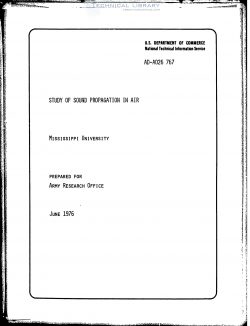USDC-AD-A026-767
- Version
- 152 Downloads
- 688.04 KB File Size
- 1 File Count
- March 7, 2017 Create Date
- March 7, 2017 Last Updated
Army Research Office - Study of Sound Propagation in Air

The absorption Of sound by the atmosphere must be known to predict sound levels at receiving sites vell removed from the aoise source and te correct recorded noise spectra to standard conditions When making cæparisons Of the noise generated by different sources. factors which affect the intensity of the sound arriving at the receiving site can be classified as Spreading Losses Uniform spherical spreading Non—unif spreading Reflection by finite boundaries Refraction by non—uniform atmosphere Dif fraction (scattering by non—stationary atmosphere) Absorption Losses Absorption by ground and ground cover Absorption by the atmosphere Classical absorption Molecular relaxation absorptior. Of these sound propagation effects, different ones nay be the ing factor for different atmospheric conditions and for varying source—receiver placement; for any type of condition or any type of scund propa— gation path, the absorption due to classical and molecular effects are fixed for a hmogeneous atmosphere and are functions only of the propagation path distance. the humidity content, gas impurities, and the tenperature. The purpose Of the research reported here was to establish the correct values Of those fixed absorpcim losses. Prior vork In collaboration with Wyle Laboratories, with U. S. Army support. Led to the developrnt of a tiw.retical model of sound absorption in air. L This requires as input parmeters. the rate at vhich vihra— tional and rotational energy is transferred during binary molecular collisions. There are twenty four energy transfer rates Important for an
| File | Action |
|---|---|
| USDC-AD-A026-767 Study of Sound Propagation in Air.pdf | Download |

Comment On This Post